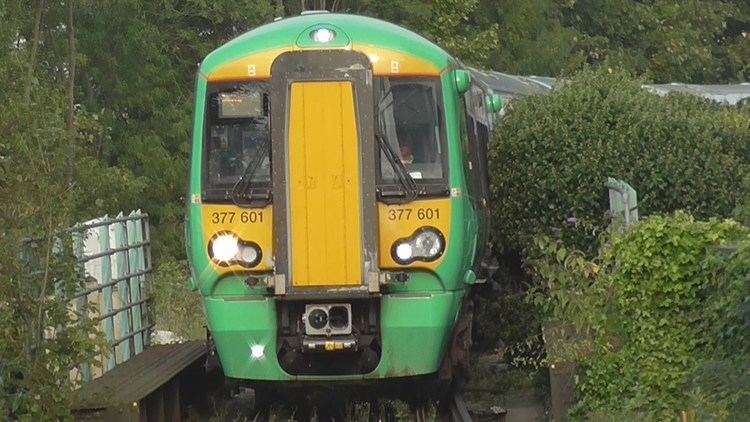Status Operational | ||
 | ||
Operator(s) South West TrainsSouthernThameslink Track gauge 1,435 mm (4 ft 8 ⁄2 in) standard gauge Rolling stocks Locale | ||
The Sutton & Mole Valley lines were constructed between 1847 and 1868 by the London, Brighton and South Coast Railway, the London and South Western Railway and the LBSCR-sponsored Horsham, Dorking and Leatherhead Railway.
Contents
Services
Services include commuter services in south London, Surrey and West Sussex operated by Southern, usually from London Victoria to Horsham via Sutton and Dorking. Some Southern services in peak hours from London Bridge call at West Croydon and diverge at Leatherhead and serve Effingham Junction and Guildford via the New Guildford Line. The South West Trains services are operated by Class 455/8. The Southern services use that same type of train, but sometimes Class 377 instead. Southern previously used Class 456 trains but these were transferred to South West Trains in March 2014. SWT plan to re-release these on the line in around November 2014.
South West Trains operates services between London Waterloo and Leatherhead via Raynes Park and Epsom. Half continue along the main line to Dorking, others run to Guildford via Bookham and Effingham Junction.
Thameslink operates services from Tulse Hill to Sutton as part of the Thameslink route to London Blackfriars and Luton using Class 319 trains.
Technical information
The route from Raynes Park to Horsham via Epsom and Dorking (including the Bookham Branch) is known to commuters as the Mole Valley Line – seven out of the 15 stations are in the Surrey district of Mole Valley. The full title Sutton and Mole Valley Lines is used for the lines north of Epsom via Sutton. Confusingly, all Southern services that terminate or call at Sutton are branded as Sutton and Mole Valley Line services.
The lines which form the route include (in order of construction):
None of the lines leads directly to a London terminus, but services use the South Western Main Line to access London Waterloo, the Brighton Main Line to access London Victoria and the Brighton Main Line (via Norwood Junction) or the South London Line (via South Bermondsey) to access London Bridge.
The following lines are associated with the route, but are considered separate:
The lines are electrified at 750 V DC third rail. Class 455 electrical multiple units are used, with semi-fast and stopping services to Horsham from London Victoria frequently operated by Class 377 Electrostars. Up to the early 1980s, express services to Littlehampton and Bognor Regis were routed along these lines and called at Sutton, Dorking, Horsham and stations to the south coast along the Arun Valley Line & West Coastway Line.
The maximum speed is 50 miles per hour (80 km/h), with 20 miles per hour (32 km/h) restrictions at Clapham Junction, Streatham Junction, Mitcham Junction, Raynes Park, West Croydon, Sutton and Epsom; 30 miles per hour (48 km/h) at Dorking and the approach to London Victoria; and 75 miles per hour (121 km/h) between Box Hill and Westhumble and Dorking, and between Dorking and Holmwood. Signalling between London Victoria and Ewell East (including the Epsom Downs Branch) is controlled by London Victoria (VC); between London Waterloo and Box Hill and Westhumble by Wimbledon (W); between Box Hill and Westhumble and Warnham by Dorking (CBK); and between West Croydon & Waddon and Warnham & Horsham by Three Bridges Signalling Centre (T).
Platform lengths have been extended recently at most stations with 12 car length platforms at Sutton, Horsham and Dorking and 10 car platforms at most other stations including Ashtead, Ewell East and Epsom.
History of the route
The lines used were the result of several schemes:
Accidents and incidents
Tunnels
There are two tunnels, built between 1860 and 1867.
Mickleham Tunnel is midway between Leatherhead and Box Hill & Westhumble. It is 524 yards (479 m) long and runs through the lower chalk of Norbury Park, entering the hillside immediately north of one of the three viaducts over the River Mole. Restrictions imposed by the landowner, Thomas Grissell, meant that vertical ventillation shafts could not be constructed and the tunnel portals were given lavish architectural treatment.
Betchworth Tunnel is 0.25 miles (0.40 km) south of Dorking. It is 385 yards (352 m) long with a maximum gradient of 1 in 80 (1.25 per cent). It runs through the upper greensand of the Deepdene Ridge to the east of the town. Construction difficulties delayed the opening south of Dorking. It collapsed on 27 July 1887, remaining closed for over six months.
